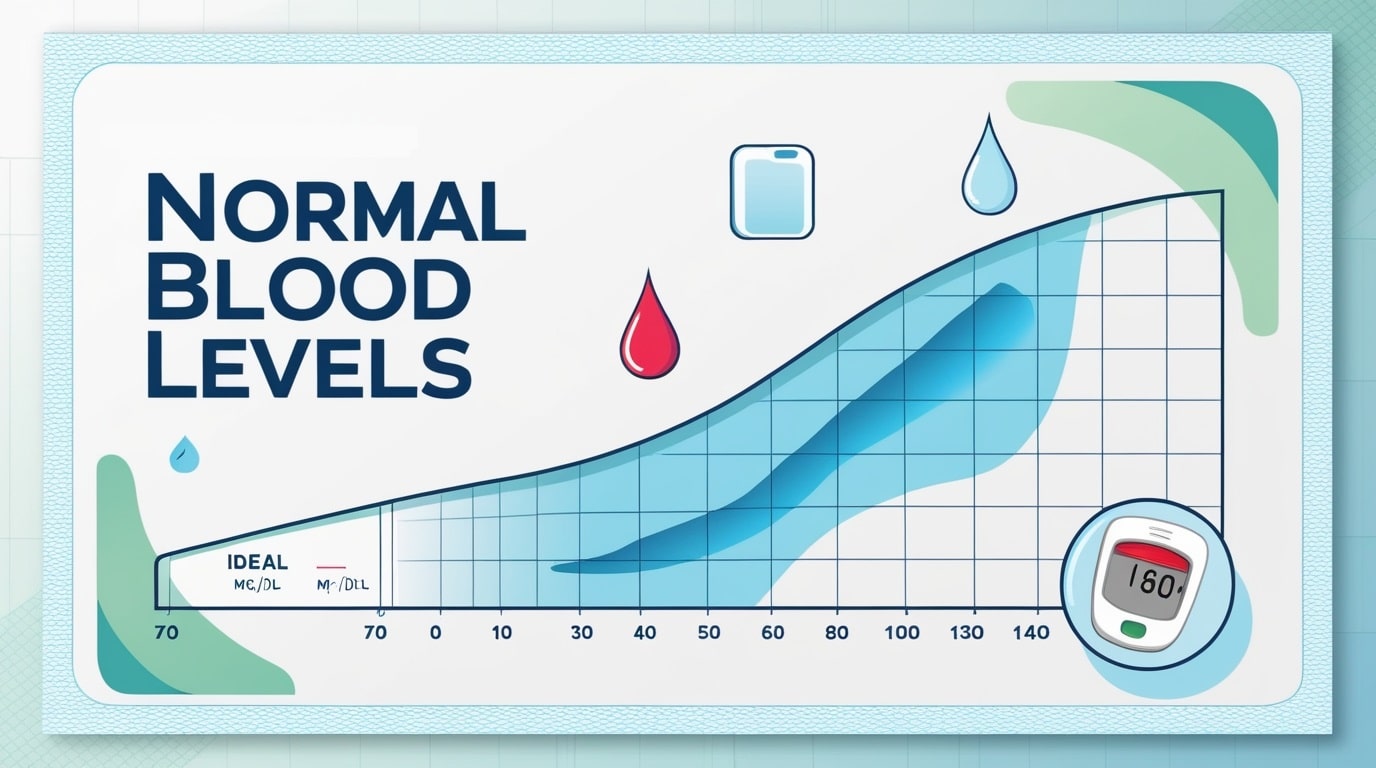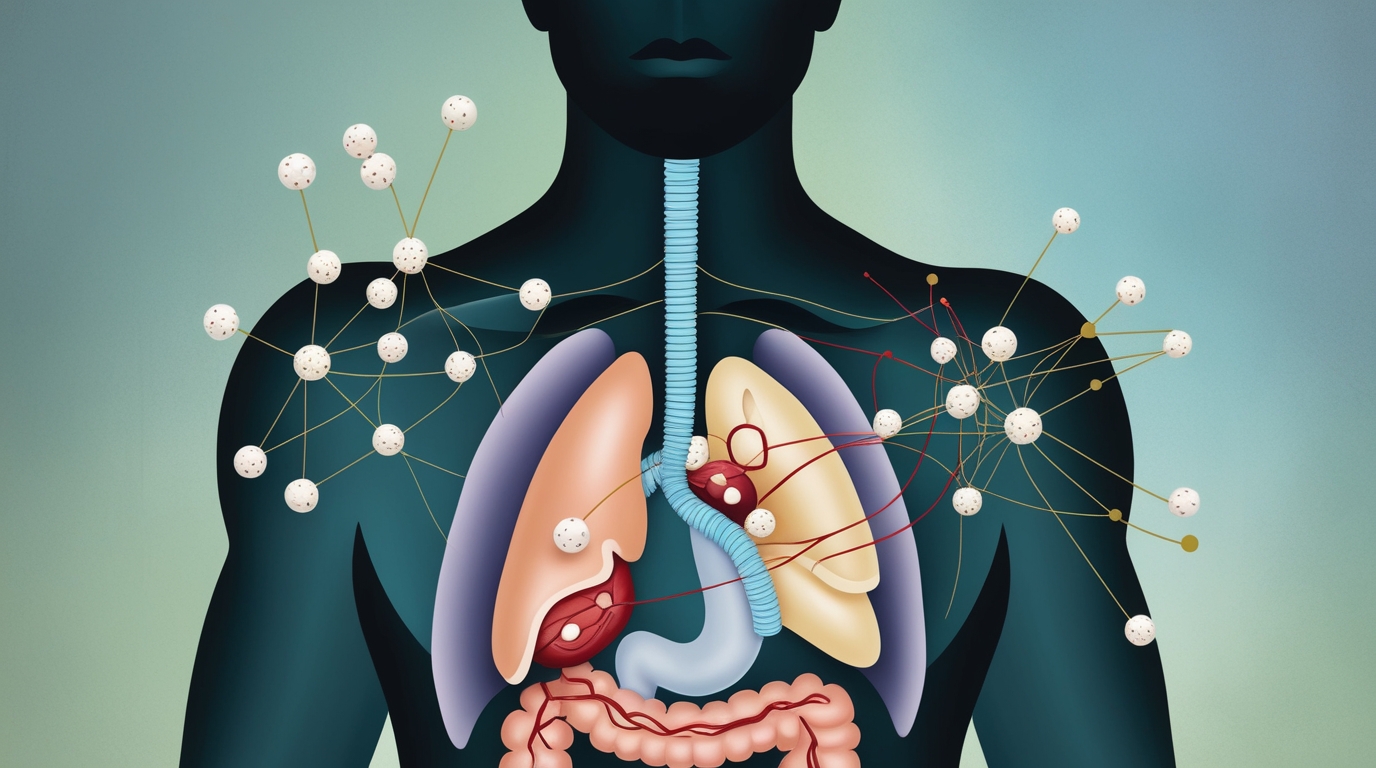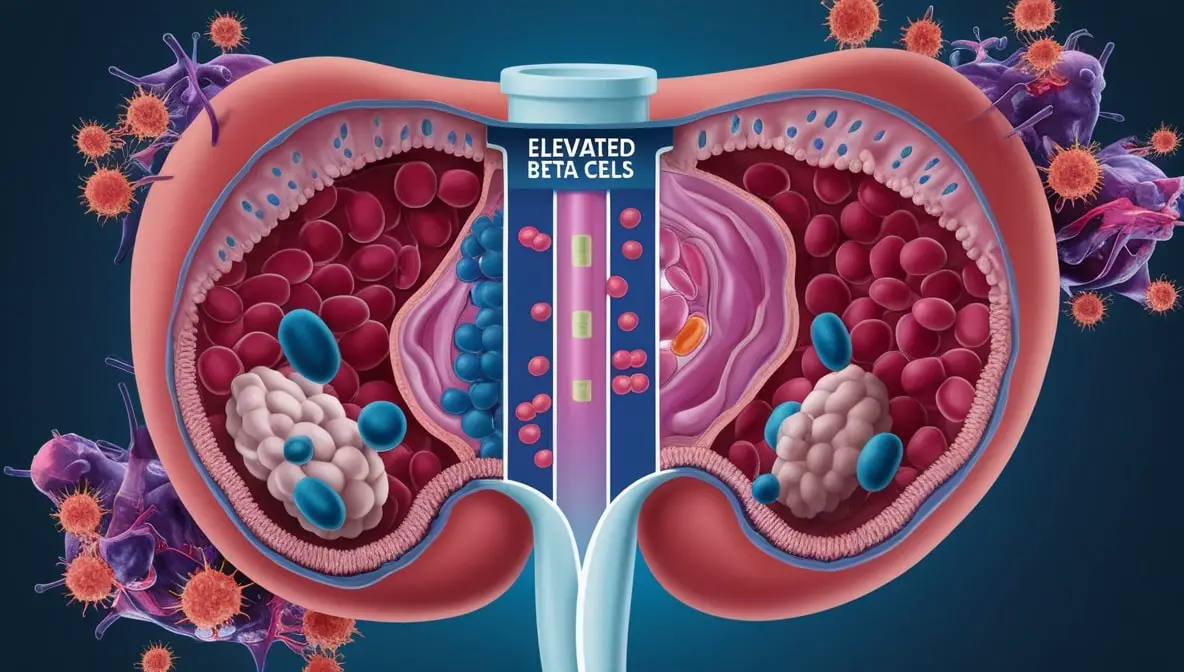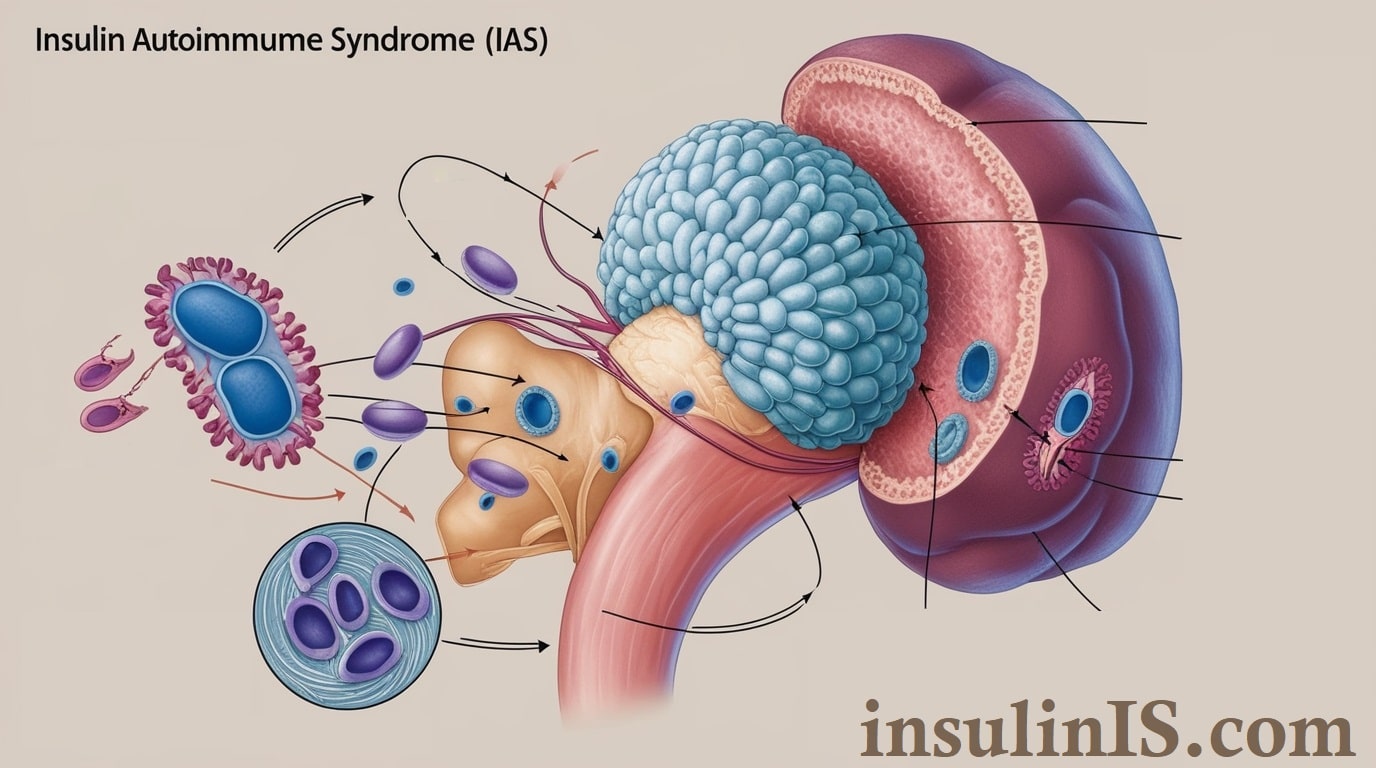Blood sugar (glucose) is a primary source of energy for your body. Maintaining it within a healthy range is crucial to avoid both short-term and long-term health complications.
- Sugar level normal range typically falls between 70–140 mg/dL (3.9–7.8 mmol/L) depending on various factors such as timing of meals, age, and individual health status.
- For adults without diabetes, fasting levels under 100 mg/dL (5.6 mmol/L) and post-meal levels generally less than 140 mg/dL (7.8 mmol/L) are often considered optimal.
- In people with diabetes, personalized targets may vary; consult a healthcare provider to establish individualized goals.
Common types of blood sugar level charts
Blood sugar level charts can vary depending on the purpose and audience. Here are the common types of blood sugar level charts:
1. Fasting Blood Sugar (FBS) Chart
- Shows normal, prediabetic, and diabetic ranges for blood sugar levels after an 8-12 hour fast.
- Example:
- Normal: 70–99 mg/dL (3.9–5.5 mmol/L)
- Prediabetes: 100–125 mg/dL (5.6–6.9 mmol/L)
- Diabetes: ≥126 mg/dL (≥7.0 mmol/L)
2. Postprandial Blood Sugar (PPBS) Chart
- Tracks blood sugar levels 1-2 hours after a meal.
- Example:
- Normal: <140 mg/dL (<7.8 mmol/L)
- Prediabetes: 140–199 mg/dL (7.8–11.0 mmol/L)
- Diabetes: ≥200 mg/dL (≥11.1 mmol/L)
3. Random Blood Sugar (RBS) Chart
- Indicates blood sugar levels regardless of meal timing.
- Example:
- Normal: <140 mg/dL (<7.8 mmol/L)
- Diabetes: ≥200 mg/dL (≥11.1 mmol/L)
4. Hemoglobin A1c (HbA1c) Chart
- Represents average blood sugar levels over the past 2-3 months.
- Example:
- Normal: <5.7%
- Prediabetes: 5.7–6.4%
- Diabetes: ≥6.5%
5. Continuous Glucose Monitoring (CGM) Chart
- Shows trends in blood sugar levels throughout the day and night.
- Helps identify patterns in response to food, medication, and activities.
6. Gestational Diabetes Blood Sugar Chart
- Tracks levels specific to pregnancy.
- Example:
- Fasting: <95 mg/dL (<5.3 mmol/L)
- 1 hour post-meal: <140 mg/dL (<7.8 mmol/L)
- 2 hours post-meal: <120 mg/dL (<6.7 mmol/L)
7. Oral Glucose Tolerance Test (OGTT) Chart
- Used to diagnose diabetes or gestational diabetes.
- Example:
- Fasting: <95 mg/dL (<5.3 mmol/L)
- 1 hour: <180 mg/dL (<10.0 mmol/L)
- 2 hours: <140 mg/dL (<7.8 mmol/L)
8. Hypoglycemia and Hyperglycemia Range Chart
- Identifies dangerously low or high blood sugar levels.
- Hypoglycemia: <70 mg/dL (<3.9 mmol/L)
- Hyperglycemia: >180 mg/dL (>10.0 mmol/L) after meals
Each type serves a specific purpose, tailored to monitoring or diagnosing different conditions and ensuring effective management of blood sugar levels.
Normal Blood Sugar Levels by Age Group
While guidelines remain broadly similar for healthy adults of all ages, slight variations can occur in older populations due to factors like slowed metabolism, medication use, and other health conditions.
| Age Group | Fasting Level | Post-Meal Level (2 hours) | A1C Goal |
|---|---|---|---|
| Adolescents (13–19) | 70–100 mg/dL (3.9–5.6 mmol/L) | <140 mg/dL (<7.8 mmol/L) | <5.7% (no diabetes) |
| Adults (20–50) | 70–99 mg/dL (3.9–5.5 mmol/L) | <140 mg/dL (<7.8 mmol/L) | <5.7% (no diabetes) |
| Age 50 to 60 | 70–110 mg/dL (3.9–6.1 mmol/L)* | <150 mg/dL (<8.3 mmol/L)* | <5.7% (no diabetes) |
| Seniors (60+) | 70–120 mg/dL (3.9–6.7 mmol/L)* | <160 mg/dL (<8.9 mmol/L)* | <5.7% (no diabetes) |
Quote: “While general guidelines exist, each individual’s health status, medications, and lifestyle factors can cause variations in their ideal blood glucose targets.” — [ Dr. Muracle John]
*Note: Some guidelines allow slightly higher targets for older adults to prevent hypoglycemia (dangerously low blood sugar). Always consult a healthcare professional for personalized ranges.
Summary of Normal Blood Sugar Tests and Ranges
| Test / Time | Normal Range |
|---|---|
| Fasting Plasma Glucose (FPG) | 70–99 mg/dL (3.9–5.5 mmol/L) |
| Random (Casual) Glucose | Typically <140 mg/dL (<7.8 mmol/L) |
| 2 Hours Post-Meal (OGTT)* | <140 mg/dL (<7.8 mmol/L) |
| A1C (Glycated Hemoglobin) | <5.7% |
*The Oral Glucose Tolerance Test (OGTT) is often used to diagnose gestational diabetes or when fasting results are borderline.
Normal Blood Sugar Levels Chart for Adults
Below is a general reference chart for what are commonly considered “normal” blood sugar levels in adults. Keep in mind that exact target ranges may vary slightly depending on the guidelines used (e.g., the American Diabetes Association, World Health Organization) and individual health conditions. Always consult a healthcare professional for personalized advice.
Blood Sugar (Glucose) Level Chart
| Test / Time | Normal Range | Prediabetes Range | Diabetes Threshold |
|---|---|---|---|
| Fasting Plasma Glucose (FPG) | 70–99 mg/dL (3.9–5.5 mmol/L) | 100–125 mg/dL (5.6–6.9 mmol/L) | 126 mg/dL (7.0 mmol/L) or higher |
| Oral Glucose Tolerance Test (OGTT)* | Below 140 mg/dL (7.8 mmol/L) at 2 hours | 140–199 mg/dL (7.8–11.0 mmol/L) at 2 hours | 200 mg/dL (11.1 mmol/L) or higher at 2 hours |
| Random (Casual) Plasma Glucose | Typically <140 mg/dL (<7.8 mmol/L) | — (No specific prediabetes cut-off for random) | 200 mg/dL (11.1 mmol/L) or higher |
| A1C (Glycated Hemoglobin) | <5.7% | 5.7%–6.4% | 6.5% or higher |
* The Oral Glucose Tolerance Test usually involves drinking a standardized sugary solution, then measuring blood glucose 2 hours later.
Random Blood Sugar Normal Range
- A random (casual) blood sugar test taken at any time of the day (without fasting) is normally <140 mg/dL (<7.8 mmol/L) for adults without diabetes.
- Readings above 200 mg/dL (11.1 mmol/L), especially if accompanied by symptoms such as frequent urination, excessive thirst, or unexplained weight loss, may indicate diabetes and warrant further evaluation.
What Level of Blood Sugar Is Dangerous?
A single high reading may not be immediately dangerous, but consistently high levels can lead to complications. Different thresholds can be considered “dangerous” based on context:
- Blood Sugar >180 mg/dL (10.0 mmol/L): Often indicates post-meal hyperglycemia if persistent.
- Blood Sugar ≥200 mg/dL (11.1 mmol/L): May signal diabetes if confirmed with additional testing or accompanied by classic high blood sugar symptoms.
For people with type 2 diabetes, a level persistently above 300 mg/dL (16.7 mmol/L) can be particularly dangerous and may require medical intervention to prevent complications like diabetic ketoacidosis (DKA, more common in type 1) or hyperosmolar hyperglycemic state (HHS).
Low blood sugar (<70 mg/dL) can also be dangerous. Symptoms include dizziness, sweating, confusion, and in severe cases, seizures or unconsciousness.
What Level of Blood Sugar Is Dangerous for Type 2 Diabetes?
- Consistently above 240–300 mg/dL (13.3–16.7 mmol/L): Signifies poor control and a possible crisis situation if symptoms escalate.
- Persistently elevated A1C (>9%): Suggests an average blood sugar around or above 212 mg/dL (11.8 mmol/L). This level of chronic hyperglycemia increases the risk of long-term complications such as neuropathy, retinopathy, and kidney disease.
If you live with type 2 diabetes and frequently observe high readings, contact your healthcare provider to adjust your treatment plan.
10.2 Blood Sugar Level After Eating
Blood sugar levels are often measured in mmol/L internationally. A 10.2 mmol/L reading (which converts to about 183.6 mg/dL) approximately 2 hours after eating could be slightly above the recommended post-meal target (often <7.8 mmol/L or <140 mg/dL). Occasional readings in this range may occur, but if they are consistent, discuss possible dietary, medication, or lifestyle adjustments with your doctor.
FAQs
1. What should my blood sugar be when I wake up?
- Adults without diabetes: Usually <100 mg/dL (5.6 mmol/L) after an overnight fast.
- Adults with diabetes: The target may be individualized (e.g., 80–130 mg/dL per ADA guidelines).
2. How often should I check my blood sugar?
- Depends on individual factors and medical advice. Some may only need periodic checks, while those managing diabetes may check multiple times daily.
3. Is it normal for blood sugar to rise after eating?
- Yes, post-meal blood glucose rises for everyone. For adults without diabetes, it generally stays under 140 mg/dL (7.8 mmol/L) about 1–2 hours after eating.
4. At what level do I need to worry about hypoglycemia (low blood sugar)?
- Blood sugar <70 mg/dL (3.9 mmol/L) can cause symptoms like shakiness, sweating, confusion, and is considered hypoglycemia.
5. When should I see a doctor?
- If you frequently get fasting readings >100 mg/dL (5.6 mmol/L) or random readings consistently >140 mg/dL (7.8 mmol/L).
- If you experience symptoms such as constant thirst, frequent urination, blurred vision, or unexplained weight loss.
Key Takeaways
- Normal blood sugar levels vary slightly by age and health status but generally fall between 70–140 mg/dL in healthy individuals without diabetes.
- Blood sugar level age 50 to 60 may be slightly higher than younger adults, but still aim to keep fasting readings under 110 mg/dL (6.1 mmol/L) and post-meal under 150 mg/dL (8.3 mmol/L) unless otherwise advised.
- What level of blood sugar is dangerous? Consistently high readings above 200 mg/dL (11.1 mmol/L) can signal diabetes or poor glucose control, particularly in type 2 diabetes.
- A 10.2 mmol/L (183.6 mg/dL) reading after eating is somewhat elevated; occasional spikes may occur, but repeated high measurements suggest further evaluation.
Always consult a qualified healthcare professional to interpret your blood sugar readings accurately and to tailor a management plan specific to your needs.
Summary
Maintaining balanced blood sugar (glucose) levels—typically within 70–140 mg/dL (3.9–7.8 mmol/L)—is vital for overall health. In healthy adults without diabetes, fasting glucose under 100 mg/dL (5.6 mmol/L) and post-meal readings below 140 mg/dL (7.8 mmol/L) are often ideal. Older adults may have slightly higher targets due to factors like metabolism changes and medications. Consistently elevated readings (e.g., above 200 mg/dL or 11.1 mmol/L) can indicate diabetes or poor control, whereas dangerously high levels over 300 mg/dL (16.7 mmol/L) may require urgent care. Low blood sugar (under 70 mg/dL) also poses risks. Because individual factors vary widely, consulting a healthcare professional is crucial for interpreting personal readings and setting safe, effective glucose goals.
References
References




